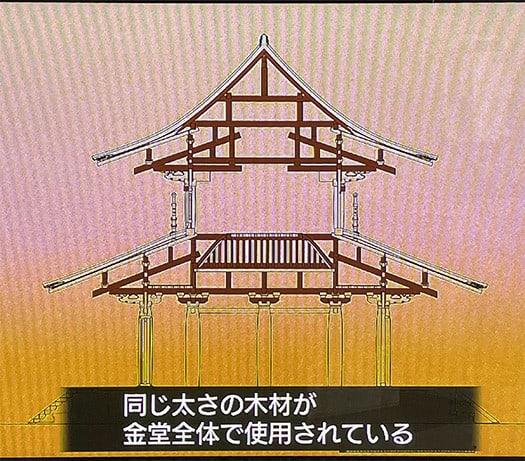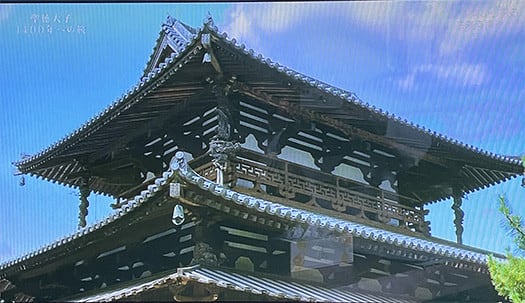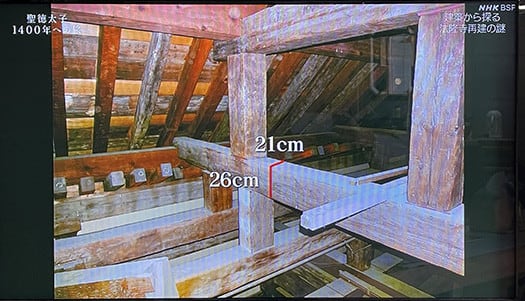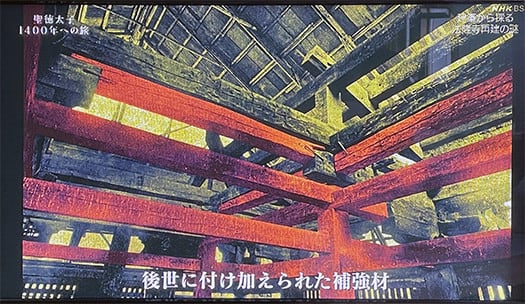



いろいろと論議の多い公共放送NHKであります。
国鉄は民営化されたけれど、もっと巨大な問題組織であるNHK、
あるいは国民共有財である電波利用を許認可で得ているに過ぎない民間放送が
さまざまな問題を起こしているのに既存メディアではスルーされている問題。
菅政権ではそうした改革が進む方向性が示されていたけれど
いまの政権からは、どういう政策を実現したいのか見えてこない。・・・
というところですが、個人的にはNHKのBSのニッチテーマ番組は好き(笑)。
民間ではコスパが悪く放送できない興味深い番組が放送されることがある。
先日カミさんが「きっと面白いと言いそうだから」と録画していてくれた番組。
「松下奈緒 聖徳太子1400年への旅」という番組で9/28に放送されていた。
先日法隆寺宮大工・西岡常一さんの弟子・小川三夫氏の講演取材を書きましたが
法隆寺古建築についての時代背景や存続してきた状況の掘り起こしテーマ。
ということでチェックして見たら非常に面白い内容に触れていた。
なんと、千年を超える世界最古の木造建築として歴世の改修履歴があり
小屋組の補強として今で言う「プレカット規格材」が使われていたと言う内容。
法隆寺は飛鳥時代、聖徳太子が建立した本格的国家公共事業・仏教建築。
四天王寺や飛鳥寺などが火災被害で後世に建て替えられたのに対して
創建間もなく一度火災消失したけれどその時点での再建以降、
今日まで世界最古の歴史を刻んできている、日本人のこころのシンボル。
このように長い歴史を刻んできたのにはそれこそ歴世の大工たちの
心魂を傾けた存続努力があったことは誰にもわかる道理。
考えて見ると法隆寺というのは建築「リフォーム」の象徴とも言える。
現代のリフォームはひたすら世界共通デザインに帰依しているけれど
日本の匠たちは原形デザインにリスペクトするこころを持ち続けてきた。
先日聞いていた小川三夫氏の講演でも、長期時間的荷重を受けて構造補強を
繰り返してきた様子をお話しされていたけれど、
聖徳太子没後、国家建築から一民間建築になっていた段階で維持管理には
ひと筋ではない苦難の経緯もあったとされていた。
今回の番組では、奈良期以降に施された構造補強の解析が説明され
26×21cmの統一的規格材が小屋裏各所に使用されている状況の活写。
番組では、創建時には各部位の材もそれぞれ独自の太さ・厚みの材が使われたが
法隆寺の経済的困窮を反映して規格材が使われていたのでは、という視点構成。
しかしわたし的には、構造補強材であり各部位での微妙な劣化変位を調整するには
一定寸法の部材の方が大工側としては合理的だったのではないかと思えた。
どうやって強度補強するかと考えたとき、
部材は一定寸法の方が現場対応しやすいのではないかと思えたのですね。
法隆寺宮大工も1400年間にはいろいろな「工夫」を考えたに違いない。
小川さんの言では大工の数だけ、手法に違いは出る、
要は木組みのクセを読み、最適な手法を発見するのが肝要ということではないか。
規格材という発想もむしろ合理主義と構造強化現場対応を表現している。
先人の「合理主義」の実証が垣間見えたようで、
非常に面白く拝見していた。・・・もうちょっと合理的にはして欲しいけれど
わたし、NHK料金はきちんと納入しております(笑)。
English version⬇
Horyu-ji Temple Pre-cut Lumber Used to Reinforce Timber Framing
A symbol of proud architectural renovation. The use of standardized dimensions was adopted for economic reasons, but the unification of lumber is rational for structural reinforcement. ...
NHK is a highly controversial public broadcaster.
The Japanese National Railways (JNR) has been privatized, but NHK, an even larger problematic organization, or private broadcasting, which is merely licensed to use the public's common property, the airwaves, is not.
Or private broadcasters who only have a license to use the public's common property, the airwaves, are causing all sorts of problems that are not being addressed by the existing media.
The Kan administration is making progress in such reforms.
The Kan administration showed a direction for such reforms, but the current administration has not yet realized what policies are needed.
The current administration does not seem to have a clear idea of what kind of policies it wants to achieve. I am not sure what kind of policies the current administration is trying to achieve.
Personally, I like NHK's BS niche theme programs (laugh).
Sometimes they broadcast interesting programs that cannot be aired in the private sector due to poor cost performance.
The other day, my wife recorded a program that she thought I would find interesting.
It was called "Nao Matsushita: A Journey to the 1,400th Anniversary of Prince Shotoku" and was broadcast on September 28.
The other day, I wrote about a lecture by Mitsuo Ogawa, a pupil of Tsunekazu Nishioka, a carpenter of Horyuji Temple.
The theme of the program is to dig up the historical background and the situation that has survived about the ancient architecture of Horyuji Temple.
So I checked it out and saw that it touched on a very interesting subject.
To my surprise, there is a history of renovation in successive generations as the world's oldest wooden building over 1,000 years old
The content said that "pre-cut standard lumber," as it is called today, was used to reinforce the hut assembly.
Horyu-ji Temple was built by Prince Shotoku during the Asuka period (710-794), and was a full-scale national public works and Buddhist architecture.
While Shitennoji Temple and Asukadera Temple were rebuilt in later periods due to fire damage, Horyuji Temple was destroyed by fire once soon after its construction.
The temple was destroyed by fire shortly after its construction, but since its reconstruction at that time, it has been the oldest building in the world to this day.
It is a symbol of the spirit of the Japanese people.
The reason for this long history is due to the efforts of successive generations of carpenters who have devoted their hearts and souls to the preservation of the temple.
The reason why Horyu-ji Temple has carved out such a long history is obvious to anyone who knows.
Horyu-ji Temple is a symbol of architectural "renovation.
Modern renovation has been relying solely on universal design.
Japanese craftsmen have kept the spirit of respect for the original design.
In a lecture given by Mitsuo Ogawa the other day, he talked about how he has repeatedly reinforced the structure under long-term loads.
He also talked about how he repeatedly reinforced the structure under long-term loads.
After the death of Prince Shotoku, the building was transformed from a national building to a private building.
However, after the death of Prince Shotoku, the building was transformed from a national building to a private one, and there were some difficulties in its maintenance.
In this program, an analysis of the structural reinforcement applied after the Nara period was explained.
The program also showed the use of 26 x 21 cm standardized lumber in various parts of the back of the building.
The program also explains that at the time of construction, each part of the building was made of its own thickness and thickness, but that this was not the case at the time of Horyuji's economic hardship.
However, I think that the standardized lumber may have been used to reflect the economic difficulties of Horyuji Temple.
However, in my opinion, it is better to use a material of a certain size for structural reinforcement and to adjust for subtle deterioration and displacement in each part of the structure.
I think it would have been more reasonable for the carpenters to use members with fixed dimensions.
When I thought about how to strengthen and reinforce the structure
I thought that it would be easier to deal with the members of a certain size at the site.
The carpenters of the Horyuji Palace must have thought of various "devices" during the 1,400 years of their construction.
Mr. Ogawa says that as many carpenters as there are, there will be differences in their methods.
In short, it is important to read the peculiarities of woodworking and find the most appropriate method.
The idea of standardized lumber is also an expression of rationalism and on-site response to structural reinforcement.
It seemed as if I caught a glimpse of a demonstration of our predecessors' "rationalism.
It was very interesting to watch. I wish they would be a little more rational, but...
I have been paying my NHK bill properly (laugh).










